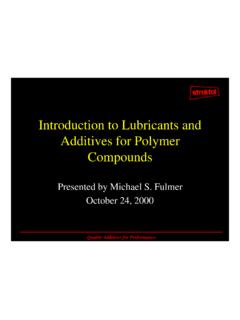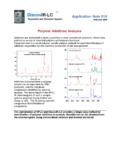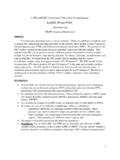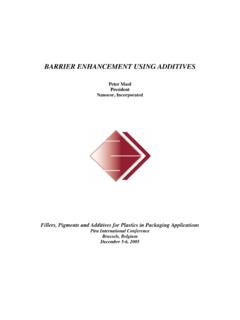Transcription of An Introduction to Bicomponent Fibers - Hills Inc.
1 An Introduction to Bicomponent Fibers Since 1971, Hills , Inc. has specialized in the design, development, and manufacture of technically advanced, custom fiber production equipment. One of our areas of specialization has been in the field of Bicomponent fiber equipment, processes, and products. While concepts and limited commercial uses of Bicomponent have been in the industry for several decades, the complexity, cost and limited production rates of the earlier fiber extrusion equipment have historically limited commercial applications, especially for the more complex Bicomponent cross sections. With recent equipment and process developments at Hills , most of these old problems have now been resolved, and we are now realizing a rapid growth in commercialization of new and complex bicomponents.
2 As the world leader in this rapidly growing field, Hills , Inc. is pleased to provide this booklet, both as a general Introduction to bicomponents, as well as a means of communicating some of Hills ' unique Bicomponent technologies. General Discussion of Bicomponent Fibers Referencing the chart on Bicomponent Fibers , the front page shows photomicrographs of 24 islands-in-the-sea Bicomponent Fibers , 16-segment pie Bicomponent Fibers , sheath/core Bicomponent Fibers , and side-by-side Bicomponent Fibers . These products were all produced by a Hills customer on a single Hills machine; all at rates equivalent to the best achievable for conventional homopolymer Fibers . The backside of the referenced Flyer shows sketches of typical Bicomponent variants. These variants are generally as follows: 1) Sheath and Core Products a) A first type of sheath/core is self bonding Fibers consisting of a low melting temperature sheath and a higher melting temperature core.
3 Common sheath/core combinations in such applications include PE/PP, PE/PET, Co-PET/PET, and PP/PET. These products are used in 100% form as well as in blends with homopolymer filaments. Staple fiber applications of these products in nonwovens is by far today's largest commercial use of Bicomponent Fibers . b) A second type of sheath/core is filled Fibers consisting of a core product produced form recycled material, conductive material or other material that is covered by a sheath that possesses desired aesthetics or other properties. c) A third type of sheath/core is a sheath polymer containing expensive additives or other attributes primarily useful on the surface of filaments. This application represents a good example of a new Bicomponent fiber type that has now been made economically viable with Hills Technology.
4 2. Side-by-Side Products Side-by-side products are usually used as self-bulking Fibers . Self-bulking is created by two polymers within a filament having a different strain level or shrinkage propensity. Higher processing speeds, reduced equipment investment, more bulk, improved hand, enhanced aesthetics, and elimination of down stream processes are among the advantages seen with this technology. Side-by-side self-bulking Fibers are now in fairly common use in staple fiber/fill applications. Recently, Hills has also commercialized such products in filament applications such as textured upholstery yarns. 3. Tipped yarns Tipped products are used to produce special aesthetics, bonding, or other properties. Hills has at least two customers with commercial applications using this technology.
5 4. Microfiber Products Microfibers can be produced by Bicomponent techniques in which the Fibers are either caused to split apart, or one of the two components is dissolved or melted away. These techniques have long been known to be capable of producing much smaller Fibers than with homopolymer techniques. However, the equipment complexity, cost, and production rates have historically caused such Fibers to be somewhat expensive. With Hills Technology, such microfibers can now be produced at a cost comparable to conventional microfibers. Some examples of such Fibers are: a) Filaments consisting of alternating segments (pies or stripes) of two different polymers that break apart during downstream processing. Examples of downstream processes used for splitting such Fibers include mild chemical treatment in dying and finishing, and hydroentanglement of staple or spunbond Fibers .
6 B) Filaments consisting of a sea component and an island component, with the sea component dissolved or melted away in subsequent processing. These products have usually been staple Fibers with the sea dissolved away in non-woven fabrics. The use of hydroentangling to break the islands apart from the sea also offers promising potential. 5. Mixed Fiber Products If a fiber producer owns Hills equipment with two polymer capabilities, it is also economical to produce various types of mixed fiber products. The ability to control the level of mix from very light, to total, to random, is easily selected and controlled. Examples of some commercial applications include the following: a) Color mixes to produce desired aesthetics. b) Denier and cross-section mixes to produce higher bulk or other desired aesthetics.
7 C) Mixes of homopolymer filaments with bicomponents at varying levels to control certain fabric properties such as bonding strength. Some useful results are also being obtained by mixing of Bicomponent cross-sections to obtain specific fiber or fabric properties Discussion of Enclosed Photomicrographs The photographs enclosed in this booklet are photomicrographs of Fibers typically produced on Hills equipment. Discussion of these photomicrographs is as follows: Photograph 1 - Sheath/Core Fibers , Round Cross-Section. This is a 10% sheath, 90% core of Co-PET/PET. In Bicomponent Fibers used for bonding, it is generally desirable to minimize sheath ratio. However, due to equipment and process limitations, most commercial products in such applications have historically used a sheath ratio of up to ~50%.
8 With Hills Technology, a sheath ratio of 10% or less can be commercially produced. In addition, some Hills customers have commercially produced perfect sheath/core Fibers with spinneret orifice spacing of < Other equipment manufacturers may claim to be able to offer such high hole density, but the cross-sections they obtain are poor; the sheath ratios are high and non-uniform; and the polymer selections useful with a specific spin pack design are very limited. Photograph 2- Sheath/Core Fiber, Trilobal Cross-Section This photomicrograph demonstrates our ability to produce low sheath ratios in the complex non-round fiber cross-sections. Photograph 3 - Side-by-Side, Trilobal Cross-Section This is an example of self-bulking Fibers commercialized in products where complex jet texturing has historically been required Photograph 4 - Sixteen Segment Pie This is an example of splittable Fibers for microdenier applications.
9 In this photomicrograph please note the high degree of perfection of the cross-sections; , the segments closely touching in the middle of each fiber, and no segment significantly sheaths another. This type of near perfection is required to control various properties such as split-ability and dyability. Achievement of this level of perfection requires precision in both the polymer distribution system and the melt viscosity of the two polymers. With Hills Technology, great attention is also paid to machine designs required to control melt viscosity. This includes properly selecting machine materials and designs for uniform heat transfer, as well as for uniform residence time from the initial melt to the spinneret face. We have even had to design our own polymer prefilters to obtain the necessary uniform residence times that are not available with commercial polymer pre-filters.
10 Photograph 5 - Thirty-Six Segment Pie While 16 pie segments is the most common number we have commercialized, it is not the limit. As shown in this photomicrograph, equal uniformity can be achieved in commercial applications with 36 or more segments Photograph 6 - Sixteen Segment Hollow Pie This cross-section was produced with a spinneret designed to produce hollow Fibers . In certain applications, these Fibers can be made to split in-line with fiber extrusion. It is also noteworthy to point out that these filaments as well as the filaments shown in Photographs 4 and 5 were all produced on a spinneret with the orifices on ~ centers. This is the same orifice spacing commonly used to produce homopolymer filaments of comparable denier per filament. Therefore, it is confirmed that with Hills Technology, these most complex Bicomponent cross-sections can now be produced at conventional machine rates.








